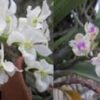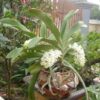The Art of Combining Dendrobium Anosmum with Other Ornamental Plants in Decor

The Dendrobium anosmum, commonly known as the Đai Châu orchid, is a remarkable species celebrated for its stunning beauty and fragrant blooms. Originating from Southeast Asia, this orchid has become a symbol of elegance and sophistication in floral arrangements and home decor. As more people embrace the art of indoor gardening and plant decor, the combination of Dendrobium anosmum with various ornamental plants has gained popularity. This article explores the aesthetics and benefits of integrating the Đai Châu orchid with other plant species, offering practical tips for creating harmonious and visually appealing indoor spaces.
## 1. Understanding Dendrobium Anosmum
### 1.1 Botanical Characteristics
Dendrobium anosmum is an epiphytic orchid characterized by its tall, slender pseudobulbs and clusters of vibrant flowers that bloom in shades of purple, lavender, and white. The flowers emit a sweet fragrance that enhances the sensory experience of any space. The plant thrives in warm, humid environments and requires specific care to flourish.
### 1.2 Cultural Significance
In many cultures, orchids symbolize love, beauty, and strength. The Dendrobium anosmum, in particular, holds special significance in Vietnamese culture, where it is often associated with romance and admiration. Understanding the cultural background of this orchid enhances its decorative value, making it a meaningful addition to various arrangements.
## 2. The Aesthetic Appeal of Combining Plants
Combining different plant species creates a dynamic visual effect that enhances the aesthetic appeal of indoor spaces. Here are several benefits of plant combinations:
### 2.1 Visual Contrast
By pairing Dendrobium anosmum with other ornamental plants, such as ferns, succulents, or foliage plants, you can create striking contrasts in color, texture, and form. The delicate flowers of the Đai Châu orchid stand out beautifully against the lush greenery of other plants, drawing attention and creating focal points in your decor.
### 2.2 Complementary Textures
Combining plants with varying leaf shapes and textures can add depth and interest to your arrangements. For instance, the slender, elongated leaves of Dendrobium anosmum can be complemented by the broad, flat leaves of a snake plant or the feathery fronds of a fern, creating a rich tapestry of greenery.
### 2.3 Enhanced Mood and Atmosphere
Plants have a profound impact on mood and atmosphere. By strategically combining Dendrobium anosmum with other plants, you can create specific themes or ambiances. For example, pairing the orchid with tropical plants like palms and philodendrons can evoke a lush, exotic vibe, while combining it with succulents can produce a modern, minimalist look.
## 3. Choosing Compatible Ornamental Plants
When selecting plants to complement Dendrobium anosmum, consider their growth habits, light requirements, and aesthetic qualities. Here are several types of plants that work well with the Đai Châu orchid:
### 3.1 Ferns
Ferns, such as the Boston fern (Nephrolepis exaltata) or maidenhair fern (Adiantum spp.), thrive in similar humidity conditions as Dendrobium anosmum. Their lush foliage creates a beautiful backdrop for the delicate blooms of the orchid, adding a soft, feathery texture to the arrangement.
### 3.2 Succulents
Succulents, like Echeveria or Haworthia, offer a striking contrast to the orchid’s elegant form. Their thick, fleshy leaves provide visual interest, and they require minimal watering, making them low-maintenance companions. The geometric shapes of succulents can create a modern aesthetic when paired with the organic shapes of orchids.
### 3.3 Foliage Plants
Foliage plants, such as pothos (Epipremnum aureum), snake plants (Sansevieria trifasciata), or peace lilies (Spathiphyllum spp.), can enhance the overall look of an arrangement with their vibrant leaves. These plants are versatile and adapt well to various light conditions, making them excellent partners for Dendrobium anosmum.
### 3.4 Tropical Plants
Incorporating tropical plants like bird of paradise (Strelitzia reginae) or bromeliads can create a stunning tropical oasis. The bold shapes and colors of these plants harmonize beautifully with the orchid, bringing a lively and exotic feel to your decor.
## 4. Designing Plant Combinations
Once you have selected compatible plants, the next step is to design arrangements that showcase their beauty. Here are some design principles to consider:
### 4.1 Balance and Symmetry
Creating balance in your arrangements helps to achieve a visually pleasing effect. You can achieve balance by arranging plants of similar heights or by using a combination of tall and short plants. For instance, placing a tall Dendrobium anosmum in the center and surrounding it with shorter foliage plants creates a harmonious arrangement.
### 4.2 Color Coordination
Color plays a vital role in plant combinations. When designing your arrangements, consider the color palette of the Dendrobium anosmum flowers and select complementary or contrasting plants. For example, pairing a lavender orchid with deep green foliage or bright-colored succulents can create a vibrant and eye-catching display.
### 4.3 Layering and Depth
To create depth in your arrangements, use plants of varying heights and shapes. Layering taller plants behind shorter ones adds dimension and visual interest. The Dendrobium anosmum, with its upright growth habit, works well as a focal point surrounded by cascading ferns or trailing pothos.
### 4.4 Container Choices
The choice of containers can significantly influence the overall look of your arrangements. Consider using decorative pots that complement the aesthetic of the plants. For example, a ceramic pot with a glossy finish can enhance the elegance of Dendrobium anosmum, while a rustic wooden planter may evoke a more natural feel when combined with ferns and foliage plants.
## 5. Care Considerations for Combined Arrangements
While combining plants can create beautiful displays, it is essential to consider their care requirements to ensure the longevity of the arrangement. Here are some tips for maintaining healthy plant combinations:
### 5.1 Watering Needs
Dendrobium anosmum requires careful watering to avoid overwatering, which can lead to root rot. When combining it with other plants, ensure that all plants have similar watering needs. For example, pairing it with succulents may not be ideal since succulents prefer drier conditions. Instead, choose plants that thrive in similar moisture levels.
### 5.2 Light Conditions
Different plants have varying light requirements. Ensure that the combination of plants you choose can thrive in the same lighting conditions. Dendrobium anosmum prefers bright, indirect light, so pairing it with shade-loving plants may hinder its growth.
### 5.3 Fertilization
Regular fertilization is essential for healthy plant growth. When combining plants, consider their fertilization needs and use a balanced fertilizer suitable for all plants in the arrangement. Be mindful of the specific needs of the Dendrobium anosmum during its growing season to encourage blooming.
### 5.4 Pest Management
Integrating various plants can sometimes attract pests. Regularly inspect your plants for signs of pests or diseases and address issues promptly to ensure the health of all plants in the arrangement. Use organic pest control methods to protect the delicate flowers of the orchid.
## 6. Creative Display Ideas
To inspire your arrangements, here are some creative display ideas that incorporate Dendrobium anosmum with other ornamental plants:
### 6.1 Vertical Gardens
Create a vertical garden by mounting Dendrobium anosmum alongside trailing plants like pothos or string of pearls (Senecio rowleyanus) on a trellis or wall planter. This design not only saves space but also adds a stunning visual element to your decor.
### 6.2 Terrariums
Combine Dendrobium anosmum with small succulents and decorative stones in a glass terrarium. This enclosed environment creates a mini-ecosystem, enhancing humidity for the orchid while providing a unique and modern display.
### 6.3 Table Centerpieces
Create a captivating table centerpiece by combining a Dendrobium anosmum in a decorative pot with low-growing ferns and small flowering plants. This arrangement can elevate the ambiance of dining spaces, adding elegance and charm.
### 6.4 Outdoor Displays
For outdoor settings, pair Dendrobium anosmum with tropical plants in a decorative planter. This combination creates a lush, exotic atmosphere, perfect for patios or garden areas.
## 7. Conclusion
Combining Dendrobium anosmum with other ornamental plants is an art form that allows for creativity and self-expression in home decor. By carefully selecting compatible plants, designing harmonious arrangements, and considering care requirements, you can create stunning displays that enhance the beauty of any indoor or outdoor space. The beauty and elegance of the Đai Châu orchid, when paired with other ornamental plants, not only adds aesthetic value but also enriches the ambiance of your surroundings. Embrace the art of plant combinations and let your creativity flourish as you transform your living spaces into vibrant, green sanctuaries.

